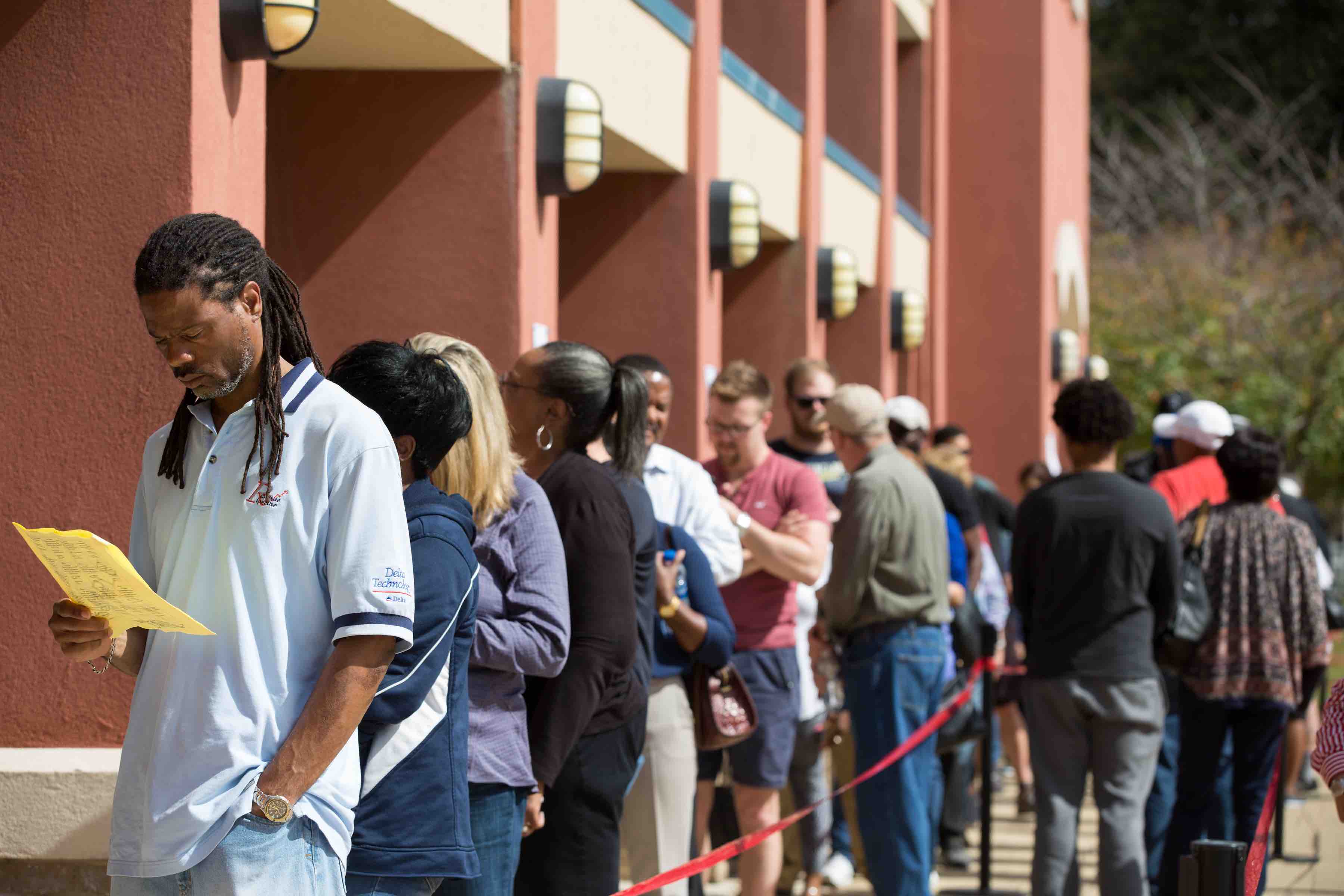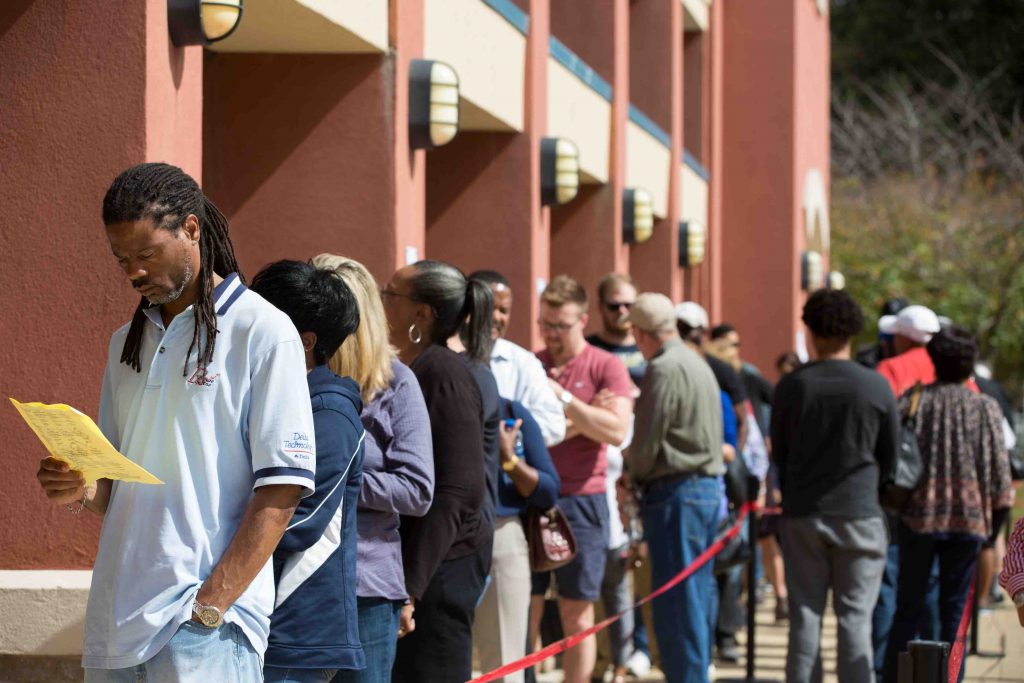The 2018 midterm elections had many firsts. It was the first time so many people of color and women were elected to political office. It was the first time in years, and in some cases decades, since Democrats had a real chance at winning races in traditionally conservative states – and some took the actual wins. (Though, notably, Latino turnout couldn’t secure a win for Democrats Beto O’Rourke in Texas and Andrew Gillum in Florida, both of whom were in high-profile races.)
It was also the first time Latinos voted in record numbers in a non-presidential election.
While final data from the election isn’t expected for a few months, absentee and early voting tallies, coupled with results from exit polls and Google searches on polling locations made in Spanish, point to Latinos voting in higher-than-normal rates. The Conversation, which based its analysis on data from Catalist, reported a nearly 120-percent increase in absentee and early ballots cast by Latinos compared to the 2014 midterms.
Results from a new survey commissioned by Voto Latino, a civic media organization, found that Latino voters are energized by the midterms and plan to stay engaged in future elections. Between November 9 and 12, Change Research conducted the survey, which suggests that future Latino voter participation will rely heavily on how invested campaign organization and political candidates are on this demographic.
The online survey, conducted on social media platforms including Facebook, included 1,586 participants below the age of 35 who identify as Hispanic, Latinx, or are from a Spanish-speaking background in the states of Arizona, California, Colorado, Florida, Nevada and Texas.
Here are seven key findings from the survey.
1
More than a quarter of Latinos were first-time voters
26 percent of Latinos surveyed said they were new voters, pointing to increased engagement of young Latinos. “It’s the very first time that we’ve seen such high-level participation rates,” said Voto Latino President Maria Teresa Kumar.
She attributes this to the number of young Latinos becoming voter eligible each year. “We are expecting a million new Latinos to turn 18 every year for the next decade,” Kumar said. “We’re literally hitting a tsunami of Latino voters. This is a like a break of the tsunami right now, but it’s not the end.”
2
94 percent plan to vote in local and national elections moving forward
While many analysts have pointed to a harsh immigration rhetoric as one of the leading causes for an upswing in Latino voters, the survey suggests the reasons are much more profound. Latinos want to make a difference in their own communities, and that means voting at the local and state levels as well.
“If we continue engaging them in the appropriate way. Providing them with the information they need, that could be game changing not only on the federal level, but really how municipalities are made up,” Kumar said.
Latinos would ultimately have more of a say on who their mayors are, who their council members are, who serves on their school board and who represents them in the State Legislature. “We’re roughly 20-percent of the population and we have less than 2-percent of representation by elected officials, this could be a game changer,” Kumar said.
3
Most Latinos felt a responsibility to vote and about one-third wanted to represent their community
Kumar attributes Latinos’ sense of responsibility to vote in large part because most are connected to immigrants in some way. They have a family member who is an immigrant or they’re an immigrant themselves.
“We have roughly 16 million Americans who live in a mixed-status household. We have to do much more background survey on it, but one of the things we’re finding is that they definitely care about that,” she said.
4
42 percent wanted more information about candidates
In her piece for The Conversation, Lisa Garcia Bedolla, a political professor at the University of California, Berkeley, argues that “Democrats competed in highly gerrymandered districts, and (President Donald) Trump’s anti-immigration appeals mobilized his base.” She believes the numbers support the logic that when candidates and campaigns engage in Latinos and the issues they care about, they will show up at the polls.
Her thinking falls in line with the survey results. Kumar said Vote Latino will strive to keep Latinos engaged on issues they care about year-round. Candidates, campaigns and organizations would also benefit from engaging with Latinos beyond campaign season.
Kumar added that 51 percent of registered Latino voters were not contacted by a campaign or party this election season. “I do believe we have to change the way we do the work and the way we depend on outside sources to invest in our community,” Kumar said. “We have to start investing in our own political power.”
5
Immigration is top issue for Latinos across the board
70 percent of voters surveyed said they are less likely to vote for a candidate who supports building a border wall. Candidates who will protect Deferred Action for Childhood Arrivals (DACA) are favored. Medicare for all is also a top priority for this demographic.
6
Campaigns matter
Voto Latino launched Somos Mas campaign earlier this year with the goal of registering 1 million new voters by 2020. The campaign seemed to resonate with voters. 64 percent of those surveyed reported identifying with the theme: “Somos Mas – Together We are More.”
As part of the campaign, Voto Latino launched VoterPal, a smart application that allows individuals to register their friends, family and community members, by scanning their drivers’ licenses. “By putting the tools and resources directly in the hands of individuals so they can register their community voters where their habits live – on their phones – we are making voter participation easier and less intimidating,” Kumar said.
7
82-percent said they'd vote for candidates dedicated to making higher education more affordable.
The vast majority said access to higher education is a top priority and would favor a candidate who makes that a platform issue. 25 percent of females surveyed said reproductive rights and health are top issues, while jobs and economy and civil rights, 16 percent and 13 percent, respectively, were top issues for males.




